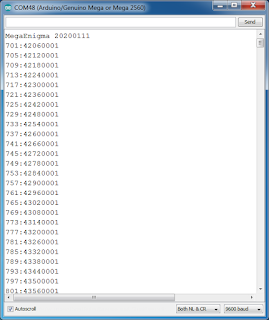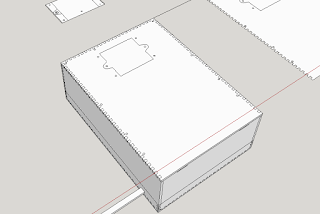This version focuses on operational realism of the enigma machine.
Sometimes, modules get a little hacky from adding features one at a time. Once all the features are defined, it is better to rewrite a function from the ground up and it comes out cleaner.
ProcessEnigma() in EnigmaGUI.ino has been rewritten, particularly case 2 in the finite state machine.
The machine has been designed to operate as follows:
Pressing a key first moves the rotors then lights up the correct result. While the rotors are moving, the contacts are not making, so nothing is illuminated.
A key must be held pressed down to illuminate a result, releasing the key turns off the lamp.
Two keys can be pressed at the same time. The way the keyboard circuit is arranged, the two top rows are in the same zone, while the bottom row is on a separate zone. The rotor up and down keys are in a separate zone. The menu key is in the same zone as the bottom row. Pushing two keys in the same zone corrupts what is displayed. Pushing keys in separate zones does not corrupt the display. Normally, only one key is pushed at a time in an enigma machine, so this zone arrangement is not part of the normal operating procedure.
If the menu key is pressed while a key is being held down and its result is illuminated in the lamp field, exiting the menu restores the current position of the rotors and the illuminated result.
While holding a key down, the rotors can be changed. The lever mechanism of the enigma machine allows each rotor to be advanced while a key is held down, but the ratchet mechanism does not allow an engaged rotor to be moved backwards while a key is pressed.
The fast rotor always turns, so if a key is pressed, it cannot be moved back to the initial position, only advanced. The middle rotors can be moved back until the stepping notch is engaged.
Changing a rotor with a key pressed down changes the output shown in the lampfield.
The plugboard is scanned dynamically. Changing a plug with a key pressed down changes the result shown in the lampfield.
The original Enigma Machine uses a two way switch in each key. If a key is not pressed, it is connected to its corresponding lamp in the lamp field. Pressing a key down connects the battery to the key and sends it to the entry rotor (ETW). The current goes through the rotor maze in and out of the reflector (UKW), and back through the rotor maze into the ETW and through an unpressed key it connects to the lamp field.
Lets use the default settings for an M4 machine with a B UKW and a Beta thin wheel and the rotors at AAAA. Pressing the V key results in E lighting up. V and E are in different zones, so both keys can be pushed down simultaneously without display corruption.
If, while holding V down, the E key is pressed, the path to the lamps would be disconnected in both ends in a real enigma machine, nothing lights up. In this simulator, this behaviour is modeled in software.
Releasing only the V key lights up the V lamp, releasing only the E key lights up the E lamp. Changing the rotors with both V and E pressed illuminates two different lamps in the lampfield. Installing or changing a plug from V or E to any other plug will illuminate two lamps in the lampfield.
So, generally, pressing a key and the key corresponding to its result simultaneously results in both lamps turning off as there is no path to the lamps.
The sequence to illuminate a key in an external USB lamp field is sent out the serial port when a key is pressed.
If the Mega Enigma Machine Simulator is connected to a computer, the Arduino IDE Serial Port Monitor can be opened used to interact with the simulator.
Sending !aaaa sets the rotors to position AAAA. Sending text encodes it. Changes to the machine configuration cannot be made through the serial port, only the rotor position can be changed.
Other unchanged features are:
Holding down the menu key results in an emergency zeroisation. All the settings are cleared and returned to a default M4 machine with B UKW and Beta additional wheel. The ring is reset to AAAA and the rotor position is changed to XXXX to indicate the settings have been cleared. Any physically installed plugs would need to be removed to complete the key erasing procedure. If software plugs were in use, they are cleared. The built in UKWD is reset to 0 as well.
The menu key is ignored for a fraction of a second when the simulator exits out of the menu and returns to the operational mode. This makes it easier to not reenter the menu and stay in operational mode if the menu key is pressed rapidly to advance through the menus and exit.
A hex uploader can be downloaded below:
https://gitlab.com/arduinoenigma/megaenigma/tree/master/compiled/MegaEnigmaV12
Full Source Code:
https://gitlab.com/arduinoenigma/megaenigma/tree/master





























